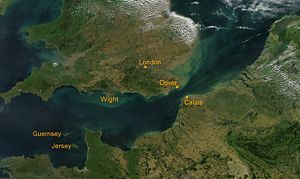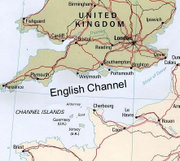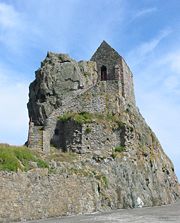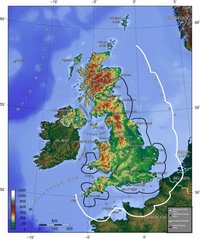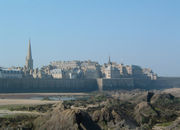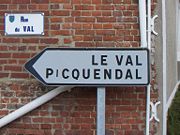English Channel
2008/9 Schools Wikipedia Selection. Related subjects: Geography
The English Channel (French: La Manche, "the sleeve") is an arm of the Atlantic Ocean that separates England from northern France and joins the North Sea to the Atlantic. It is about 562 km (350 miles) long and varies in width from 240 km (150 miles) at its widest to only 34 km (21 miles) in the Strait of Dover. It is the smallest of the shallow seas around the continental shelf of Europe, covering an area of only some 75,000 km² (29,000 square miles).
Geography
The length of the Channel is most often defined as the line between Land's End and Ushant at the (arbitrarily defined) western end, and the Strait of Dover at the eastern end. The Strait is also the Channel's narrowest point, while its widest point lies between Lyme Bay and the Gulf of Saint Malo near the midpoint of the waterway. It is relatively shallow, with an average depth of about 120 m (390 ft) at its widest part, reducing to about 45 m (150 ft) between Dover and Calais. From there eastwards the adjoining North Sea continues to shallow to about 26 m in the Broad Fourteens where it lies over the watershed of the former land bridge between East Anglia and the Low Countries. It reaches a maximum depth of 180 m (590 ft) in the submerged valley of Hurds Deep, 30 km (19 miles) northwest of Guernsey.
Several major islands are situated in the Channel, the most notable being the Isle of Wight off the English coast and the British crown dependencies the Channel Islands off the coast of France. The Isles of Scilly off the far south-west coast of England are not generally counted as being in the Channel. The coastline, particularly on the French shore, is deeply indented. The Cotentin Peninsula in France juts out into the Channel, and the Isle of Wight creates a small parallel channel known as the Solent.
The Channel is of geologically recent origins, having been dry land for most of the Pleistocene period. It is thought to have been created between 450,000 and 180,000 years ago by two catastrophic glacial lake outburst floods caused by the breaching of the Weald-Artois Anticline, a ridge which held back a large proglacial lake in the Doggerland region, now submerged under the North Sea. The flood would have lasted several months, releasing as much as one million cubic metres of water per second. The cause of the breach is not known but may have been caused by an earthquake or simply the build-up of water pressure in the lake. As well as destroying the isthmus that connected Britain to continental Europe, the flood carved a large bedrock-floored valley down the length of the English Channel, leaving behind streamlined islands and longitudinal erosional grooves characteristic of catastrophic megaflood events.
At its west end, it is narrowly separated from the Celtic Sea and Bay of Biscay by the peninsulas of Cornwall and Brittany respectively.
For the UK Shipping Forecast the English Channel is divided into the areas of (from the West):
Name
The name "English Channel" has been widely used since the early 18th century, possibly originating from the designation "Engelse Kanaal" in Dutch sea maps from the 16th century onwards. It has also been known as the "British Channel". Prior to then it was known as the British Sea, and it was called the "Oceanus Britannicus" by the 2nd century geographer Ptolemy. The same name is used on an Italian map of about 1450 which gives the alternative name of "canalites Anglie" - possibly the first recorded use of the "Channel" designation.
The French name "La Manche" has been in use since at least the 17th century. The name is usually said to refer to the Channel's sleeve (French: "manche")-like shape. However, it is sometimes claimed to instead derive from a Celtic word meaning "channel" that is also the source of the name for The Minch, in Scotland. In Spain and most Spanish speaking countries the Channel is referred to as "El Canal de la Mancha". In Portuguese it is known as "O Canal da Mancha". (It is interesting to note that that this is not a translation from French: in Portuguese, as well as in Spanish, "mancha" means "stain", while the word for sleeve is "manga".) Other languages also use this name, such as Greek (Κανάλι της Μάγχης) and Italian (la Manica).
In Breton it is known as "Mor Breizh" (the Sea of Brittany).
In southern Britain it is often referred to simply as "the Channel".
Archaeology
The geology and geography of the Channel make it a productive site for maritime archaeologists and it has thousands of shipwrecks.
In August 2007, artifacts including wood and hazelnuts from the 8000-year-old Bouldnor Cliff Mesolithic Village were presented by the Underwater Archaeology Centre based in the Isle of Wight. The preservation of organic material from the stone age is unique to the UK and already the site is of international importance.
History
| This precious stone set in the silver sea, Which serves it in the office of a wall Or as a moat defensive to a house, Against the envy of less happier lands. William Shakespeare, Richard II (Act II, Scene 2) |
The channel has been the key natural defence for Britain, halting invading armies whilst in conjunction with control of the North Sea allowing her to blockade the continent. The most significant failed invasion threats came when the Dutch and Belgian ports were held by a major continental power, e.g. from the Spanish Armada in 1588, Napoleon during the Napoleonic Wars, and Nazi Germany during World War II. Successful invasions include the Roman conquest of Britain, the Norman Conquest in 1066 and the invasion and conquest of Britain by Dutch troops under William III in 1688, whilst the concentration of excellent harbours in the Western Channel on Britain's south coast made possible the largest invasion of all times: the Normandy landings in 1944. Channel naval battles include the Battle of Goodwin Sands (1652), the Battle of Portland (1653), the Battle of La Hougue (1692) and the engagement between USS Kearsarge and CSS Alabama (1864).
In more peaceful times the channel served as a link joining shared cultures and political structures, particularly the huge Angevin Empire from 1135–1217. For nearly a thousand years, the Channel also provided a link between the Modern Celtic regions and languages of Cornwall and Brittany. Brittany was founded by Britons who fled Cornwall and Devon after Anglo-Saxon encroachment. In Brittany, there is a region known as " Cornouaille" (Cornwall) in French and "Kernev" in Breton (cf "Kernow", the Cornish for Cornwall). Anciently there was also a " Domnonia" (Devon) in Brittany as well.
The way to the British Isles
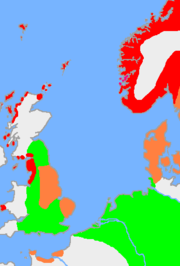
Diodorus Siculus and Pliny both suggest trade between the rebel celtic tribes of Armorica and Iron Age Britain flourished. In 55 BC Julius Caesar invaded claiming that the Britons had aided the Veneti against him the previous year. He was more successful in 54 BC but Britain wasn't fully established as part of the Roman Empire until completion of the invasion by Aulus Plautius in 43 AD. A brisk and regular trade began between ports in Roman Gaul and those in Britain. This traffic continued until the Roman departure from Britain in 410 AD after which we enter early Anglo-Saxon times and historical records are generally far less clear.
In the power vacuum left by the retreating Romans, the Germanic Angles, Saxons, and Jutes began the next great migration across the North Sea. Having already been used as mercenaries in Britain by the Romans, many people from these tribes migrated across the North Sea during the Migration Period, conquering and perhaps displacing the native Celtic populations.
Norsemen and Normans
The attack on Lindisfarne in 793 is generally considered the beginning of the Viking Age. For the next 250 years the Scandinavian raiders of Norway, Sweden, and Denmark dominated the North Sea, raiding monasteries, homes, and towns along the coast and along the rivers that ran inland. According to the Anglo-Saxon Chronicle they began to settle in Britain in 851. They continued to settle in the British Isles and the continent until around 1050.
The fiefdom of Normandy was created for the Viking leader Rollo (also known as Robert of Normandy). Rollo had besieged Paris but in 911 entered vassalage to the king of the West Franks Charles the Simple through the Treaty of St.-Claire-sur-Epte. In exchange for his homage and fealty, Rollo legally gained the territory he and his Viking allies had previously conquered. The name "Normandy" reflects Rollo's Viking (i.e. "Northman") origins.
The descendants of Rollo and his followers adopted the local Gallo-Romantic language and intermarried with the area’s previous inhabitants and became the Normans – a Norman French-speaking mixture of Scandinavians, Hiberno-Norse, Orcadians, Anglo-Danish, and indigenous Franks and Gauls.
Rollo's descendant William, Duke of Normandy became king of England in 1066 in the Norman Conquest culminating at the Battle of Hastings while retaining the fiefdom of Normandy for himself and his descendants. In 1204, during the reign of King John, mainland Normandy was taken from England by France under Philip II while insular Normandy (the Channel Islands) remained under English control. In 1259, Henry III of England recognized the legality of French possession of mainland Normandy under the Treaty of Paris. His successors, however, often fought to regain control of mainland French Normandy.
With the rise of William the Conqueror the North Sea and Channel began to lose some of its importance. The new order oriented most of England and Scandinavia's trade south, toward the Mediterranean and the Orient.
Although the British surrendered claims to mainland Normandy and other French possessions in 1801, the monarch of the United Kingdom retains the title Duke of Normandy in respect to the Channel Islands. The Channel Islands (except for Chausey) remain a Crown dependency of the British Crown in the present era. Thus the Loyal Toast in the Channel Islands is La Reine, notre Duc ("The Queen, our Duke"). The British monarch is understood to not be the Duke of Normandy in regards of the French region of Normandy described herein, by virtue of the Treaty of Paris of 1259, the surrender of French possessions in 1801, and the belief that the rights of succession to that title are subject to Salic Law which excludes inheritance through female heirs.
French Normandy was occupied by English forces during the Hundred Years' War in 1346–1360 and again in 1415–1450.
Britain: the naval superpower
From the reign of Elizabeth I, English foreign policy concentrated on preventing invasion across the Channel by ensuring no major European power controlled the potential Dutch and Flemish invasion ports. Her climb to the pre-eminent sea power of the world began in 1588 as the attempted invasion of the Spanish Armada was defeated by the combination of outstanding naval tactics by the English under command of Sir Francis Drake and the breaking of the bad weather. The strengthened English Navy waged several wars with their continental neighbours and by the end of the 18th century had erased the Dutch's previously world-spanning empire.
The building of the British Empire was possible only because the British navy exercised unquestioned control over the seas around Europe, especially the Channel and the North Sea. The only significant challenge to British domination of the seas came during the Napoleonic Wars. The Battle of Trafalgar took place off the coast of Spain against a combined French and Spanish fleet and was won by Admiral Horatio Nelson, ending Napoleon's plans for a cross-Channel invasion and securing British dominance of the seas for over a century.
The First World War
The exceptional strategic importance of the Channel as a tool for blockade was recognised by the First Sea Lord Admiral Fisher in the years before WW1.
"Five keys lock up the world! Singapore, the Cape, Alexandria, Gibraltar, Dover."
Because the Kaiserliche Marine surface fleet could not match the British Grand Fleet, the Germans developed submarine warfare which was to become a far greater threat to Britain. The Dover Patrol was set up just before war started to escort cross-Channel troopships and to prevent submarines from accessing the Channel, thereby obliging them to travel to the Atlantic via the much longer route around Scotland.
On January 31st 1917 the Germans restarted unrestricted submarine warfare leading to dire Admiralty predictions that submarines would defeat Britain by November, the most dangerous situation Britain faced in either World War.
The Battle of Passchendaele in 1917, was fought to reduce the threat by capturing the submarine bases on the Belgian coast though it was the introduction of convoys and not capture of the bases that averted defeat. In April 1918 the Dover patrol carried out the famous Zeebrugge Raid against the U boat bases. The Naval blockade effected via the Channel and North Sea was one of the decisive factors in the German defeat in 1918.
The Second World War
During the Second World War, naval activity in the European theatre was primarily limited to the Atlantic (see Battle of the Atlantic). The early stages of the Battle of Britain featured air attacks on Channel shipping and ports and until the Normandy landings with the exception of the Channel Dash the narrow waters were too dangerous for major warships. However, despite these early successes against shipping, the Germans did not win the air supremacy necessary for a cross Channel invasion.
The Channel subsequently became the stage for an intensive coastal war, featuring submarines, minesweepers, and Fast Attack Craft.
The town of Dieppe was the site of the ill-fated Dieppe Raid by Canadian and British armed forces. More successful was the later Operation Overlord (also known as D-Day), a massive invasion of German-occupied France by Allied troops. Caen, Cherbourg, Carentan, Falaise and other Norman towns endured many casualties in the fight for the province, which continued until the closing of the so-called Falaise gap between Chambois and Montormel, then liberation of Le Havre.
The Channel Islands were the only part of the British Commonwealth occupied by Germany (excepting the part of Egypt occupied by the Afrika Korps at the time of the Second Battle of El Alamein). The German occupation 1940–1945 was harsh, with some island residents being taken for slave labour on the Continent; native Jews sent to concentration camps; partisan resistance and retribution; accusations of collaboration; and slave labour (primarily Russians and eastern Europeans) being brought to the islands to build fortifications. The Royal Navy blockaded the islands from time to time, particularly following the liberation of mainland Normandy in 1944. Intense negotiations resulted in some Red Cross humanitarian aid, but there was considerable hunger and privation during the five years of German occupation particularly in the final months when the population was close to starvation. The German troops on the islands surrendered on 9 May 1945 only a few days after the final surrender in mainland Europe.
Population
The English Channel is densely populated on both shores, on which are situated a number of major ports and resorts possessing a combined population of over 3.5 million people. The most significant towns and cities along the Channel (each with more than 20,000 inhabitants, ranked in descending order; populations are the urban area populations from the 1999 French census, 2001 UK census, and 2001 Jersey census) are as follows:
English side

- Brighton– Worthing– Littlehampton: 461,181 inhabitants
- Portsmouth: 442,252
- Bournemouth & Poole: 383,713
- Southampton: 304,400
- Plymouth: 243,795
- Torbay ( Torquay): 129,702
- Hastings– Bexhill: 126,386
- Eastbourne: 106,562
- Bognor Regis: 62,141
- Folkestone– Hythe: 60,039
- Weymouth: 56,043
- Dover: 39,078
- Exmouth: 32,972
- Falmouth– Penryn: 28,801
- Ryde: 22,806
- Seaford: 21,851
- Penzance: 20,255
French side
- Le Havre: 248,547 inhabitants
- Calais: 104,852
- Boulogne-sur-Mer: 92,704
- Cherbourg: 89,704
- Saint-Brieuc: 85,849
- Saint-Malo: 50,675
- Lannion– Perros-Guirec: 48,990
- Dieppe: 42,202
- Morlaix: 35,996
- Dinard: 25,006
- Étaples– Le Touquet-Paris-Plage: 23,994
- Fécamp: 22,717
- Eu– Le Tréport: 22,019
- Trouville-sur-Mer– Deauville: 20,406
- Berck: 20,113
Channel Islands
- Saint Helier: 28,310 inhabitants
- Saint Peter Port: 16,488 inhabitants
Shipping
The Channel, with traffic in both the UK-Europe and North Sea-Atlantic routes, is one of the World's busiest seaways carrying over 400 ships per day. Following an accident in January 1971 and a series of disastrous collisions with wreckage in February,, the Dover Traffic Separation System (TSS) the World's first Radar controlled TSS was set up by the International Maritime Organization.
In December 2002 the MV Tricolor, carrying £30m of luxury cars sank 32km (20m) north west of Dunkirk after collision in fog with the container ship Kariba. The cargo ship Nicola ran into the wreckage the next day. However, there was no loss of life.
The shore-based long range traffic control system was updated in 2003 and is one of the most advanced systems in the world. Though the system is inherently incapable of reaching the levels of safety obtained from aviation systems such as the Traffic Collision Avoidance System, it has reduced accidents to one or two a year.
Marine GPS systems allow ships to be preprogrammed to follow navigational channels accurately and automatically, further avoiding risk of running aground, but following the fatal collision between Dutch Aquamarine and Ash in October 2001, Britain's Marine Accident Investigation Branch (MAIB) issued a safety bulletin saying it believed that in these most unusual circumstances GPS use had actually contributed to the collision. The ships were maintaining a very precise automated course, one directly behind the other, rather than making use of the full width of the traffic lanes as a human navigator would.
A combination of radar difficulties in monitoring areas near cliffs, a failure of a CCTV system, incorrect operation of the anchor, the inability of the crew to follow standard procedures of using a GPS to provide early warning of the ship dragging the anchor and reluctance to admit the mistake and start the engine led to the MV Willy running aground in Cawsand bay, Cornwall in January 2002. The Marine Accident Investigation Branch report makes it clear that the harbour controllers were actually informed of impending disaster by shore observers even before the crew were themselves aware. The village of Kingsand was evacuated for 3 days due to very serious risk of explosion and the ship was stranded for 11 days.
Because of the risk to life from large vessels manoeuvring in narrow shipping lanes, unorthodox crossing of the Dover Straits is banned under French Law, the only exception being for Cross Channel swimming attempts organised and approved by the Channel Swimming Association (CSA) and (CS&PF).
Ecology
As a busy shipping lane, the English Channel experiences environmental problems following accidents involving ships with toxic cargo and oil spills. Indeed over 40% of the UK incidents threatening pollution occur in or very near the Channel. One of the best known and least loved was the MSC Napoli, which with nearly 1700 tonnes of dangerous cargo was controversially beached in Lyme bay, a protected World Heritage Site coastline. The ship had been damaged and was en route to Portland when much nearer harbours were available.
Transport links
Ferry
Important ferry routes are:
- Dover-Calais
- Dover- Boulogne
- Newhaven-Dieppe
- Portsmouth-Caen (Ouistreham)
- Portsmouth-Cherbourg
- Portsmouth-Le Havre
- Poole-Saint Malo
- Poole-Cherbourg
- Weymouth-Saint Malo
- Plymouth-Roscoff
Channel Tunnel
Many travellers cross beneath the English Channel using the Channel Tunnel. This engineering feat, first proposed in the early 19th century and finally realised in 1994, connects the UK and France by rail. It is now routine to travel between Paris, Brussels and London on the Eurostar train. Cars can also travel on special trains between Folkestone and Calais.
Economy
Tourism
The coastal resorts of the channel, such as Brighton and Deauville, inaugurated an era of aristocratic tourism in the early 19th century, which developed into the seaside tourism that has shaped resorts around the world. Short trips across the channel for leisure purposes are often referred to as Channel Hopping.
Culture and languages
The two dominant cultures are English on the north shore of the Channel, and French on the south shore. However, there are also a number of minority languages that are/were found on the shores and islands of the English Channel, which are listed here, with the Channel's name following them.
Celtic Languages
- Breton (Brezhoneg) - "Mor Breizh" (Sea of Brittany)
- Cornish (Kernuack) - "Chanel"
Germanic languages
- Dutch (West Flemish) - "Het Kanaal" (the Channel)
Dutch previously had a larger range, and extended into parts of the modern-day French state. For more information, please see French Flemish.
Romance Languages
- French language - "La Manche"
- Gallo
- Norman, including the Channel Island vernaculars -
- Anglo-Norman (extinct, but still fossilised in certain English law phrases)
- Auregnais (extinct)
- Cotentinais - Maunche
- Guernesiais - Ch'nal
- Jèrriais - Ch'na
- Sercquais
- Picard
The English Channel has a variety of names in these languages. In Breton, it is known as Mor Breizh meaning the Sea of Brittany; in Norman, the Channel Island dialects use forms of "channel", e.g. Ch'nal, whereas the Mainland dialects tend more towards the French as in Maunche. In Flemish and Dutch it is Het Kanaal (the channel).
Most other languages tend towards variants of the French and English forms, but notably Welsh has "Môr Udd"
Notable channel crossings
As one of the narrowest but most famous international waterways lacking dangerous currents, crossing the Channel has been the first objective of a number of innovative sea, air and human powered technologies. Some of these are given below.
| Date | Crossing | Participant(s) | Notes |
|---|---|---|---|
| 7 January 1785 | First crossing by air (in balloon, from Dover to Calais) | Jean-Pierre Blanchard (France) John Jeffries (U.S.) |
— |
| 15 June 1785 | First air crash (in combination hydrogen / hot-air balloon) |
Pilâtre de Rozier (France) Pierre Romain (France) | Attempted crossing similar to Blanchard/Jeffries |
| 25 August 1875 | First known person to swim the channel (Dover to Calais, 21 hrs, 45 min) | Matthew Webb (UK) | Attempted crossing on 12 August the same year; forced to abandon swim due to strong winds/rough sea conditions |
| 27 March 1899 | First radio transmission across the Channel (from ( Wimereux to South Foreland Lighthouse) | Guglielmo Marconi (Italy) | |
| 25 July 1909 | First person to cross the channel in a heavier-than-air aircraft (the Blériot XI) (Calais to Dover, 37 minutes) | Louis Blériot (France) | Encouraged by £1000 prize being offered by the Daily Mail for first successful flight across the channel |
| 23 August 1910 | First aircraft flight with passengers | John Bevins Moisant (U.S.) | Passengers were mechanic Albert Fileux and Moisant's cat. |
| 16 April 1912 | First woman to fly across the English channel (Dover to Calais, 59 minutes) | Harriet Quimby (US) | Her accomplishment did not receive much media attention, as the Titanic had sunk the evening before. |
| 23 August 1926 | First woman to swim across the channel ( Cap Griz Nez to Kingsdown, 14 hours 39 minutes) | Gertrude Ederle (US) | Five men had successfully swam the channel before Ederle. Ederle beat their best time by two hours, creating a record for a female swimmer that stood until Florence Chadwick swam it in 13 hours 20 minutes in 1950. |
| 25 July 1959 | Hovercraft crossing (Calais to Dover, 2 hours 3 minutes) | SR-N1 | Sir Christopher Cockerell was on board |
| 22 August 1972 | First solo hovercraft crossing (same route as SR-N1; 2 hours 20 minutes) | Nigel Beale (UK) | |
| 12 June 1979 | First human-powered aircraft to fly over the channel (in 70-pound (32 kg) Gossamer Albatross) |
Bryan Allen (U.S.) | Won a £100,000 Kremer Prize; Allen pedalled for three hours |
| 14 September 1995 | Fastest crossing by hovercraft, 22 minutes by "Princess Anne" | MCH SR-N4 MkIII | Craft was designed to work as a ferry |
| 1997 | First vessel to complete a solar-powered crossing using photovoltaic cells. | SB Collinda | — |
| 14 June 2004 | New record time for crossing in amphibious vehicle (the Gibbs Aquada, two-seater open-top sports car) | Richard Branson (UK) | Completed crossing in 100 min 06 sec. Broke record by about six hours. |
| 26 July 2006 | New record time for crossing in hydrofoil car (the Rinspeed Splash, two-seater open-top sports car) | Frank M. Rinderknecht (SUI) | Completed crossing in 194 min ( link with photos) |
| 25 September 2006 | 1st crossing on an Inflateable, the boat was piloted by Mark who is partially blind | Stephen Preston (Stupid Steve) (ENG) | Completed crossing in 180 min ( link with photos) |
By boat
Pierre Andriel crossed the English Channel aboard the Élise in 1815, one of the earliest sea going voyages by steam ship .
The Mountbatten class hovercraft (MCH) entered commercial service in August 1968 initially operated between Dover and Boulogne but later craft also made the Ramsgate ( Pegwell Bay) to Calais route. The journey time, Dover to Boulogne, was roughly 35 minutes, with six trips a day at peak times. The fastest ever crossing of the English Channel by a commercial car-carrying hovercraft was 22 minutes, recorded by the Princess Anne MCH SR-N4 Mk3 on 14 September 1995, for the 10:00 am service.
The youngest recorded sailors to cross the channel by boat are Hugo Sunnucks and Guy Harrison aged 15 (formula 18 catamaran). They completed in 4 hours 15 mins in August 2006.
By swimming
The sport of Channel Swimming traces its origins to the latter part of the 19th century when Captain Matthew Webb made the first observed and unassisted swim across the Strait of Dover swimming from England to France on 24 August 1875 – 25 August 1875 in 21 hours and 45 minutes.
In 1927 (at a time when fewer than ten swimmers had managed to emulate the feat and a number of dubious claims were being made), the Channel Swimming Association (the CSA) was founded to authenticate and ratify swimmers' claims to have swum the English Channel and to verify crossing times. The CSA was dissolved in 1999 and succeeded by two separate organisations: The CSA (Ltd) and the Channel Swimming and Piloting Federation (CSPF) ( website). Both organisations are registered with the international governing body for swimming Fédération Internationale de Natation Amateur (FINA) ( website) and observe and authenticate cross-Channel swims in the Strait of Dover.
Although the swimming rules and regulations of the two organisations are virtually identical, the CSA has not always been prepared to recognise swims conducted under the auspices of the larger and more popular CSPF.
A comprehensive list of all registered and verified solo and relay swims is available from http://www.dover.uk.com/channelswimming/
For a list of Channel Swimming Association Records for swims registered only under the rules of the Channel Swimming Association and verified by that body, go to http://www.channelswimmingassociation.com
- On 24 August 1875 – 25 August 1875 Capt. Matthew Webb made the first crossing of the English Channel from England to France.
- On 12 August 1923 Enrico Tiraboschi made the first crossing of the English Channel from France to England.
- On 6 August 1926, Gertrude Ederle became the first woman to swim the Channel. She did it in 14 hours and 31 minutes, breaking the men's record of the time by two hours. However, this swim attracted some controversy. On 16 August, The Westminster Gazette reported locals as saying that "Miss Ederle swam under the lea of one of the accompanying tugs" while another boat "navigated in such a manner as to keep the heavy seas and tides off her" and that "Miss Ederle was drawn along by the suction of the tug so that she was able to swim at about twice the speed she would have been able to swim under ordinary conditions." The Dover Express and East Kent News commented that "So far little information has been given of the detail of Miss Ederle's swim. The most extraordinary thing about it being that she made no westward drift with the ebb tide, which on the day in question ran westward for nearly seven hours."
- On 7 October 1927, Mercedes Gleitze became, at her eighth attempt, the first British woman to swim the channel. She swam from France to England in 15 hours and 15 minutes. Because of a claim which was soon proven to be false, by Dr. Dorothy Cochrane Logan (using her professional name, Mona McLennan), to have swum the Channel on October 11th in the faster time of thirteen hours and ten minutes, Gleitze's own claim was cast into doubt. To silence the doubters, Gleitze decided to repeat her feat in what was called "the vindication swim". On October 21st at 4:21 am she entered the water at Cap Gris Nez. But this time the water was much colder, and she was unable to complete the crossing. At 2:45 pm she was pulled semi-conscious from the water after 10 hours and 24 minutes, some seven miles (11 km) short of the English shore. She might have been disappointed at not completing the swim, but after witnessing her strength, courage, and determination, nobody doubted the legitimacy of her previous swim, and she was hailed as a heroine. As she sat in the boat, one journalist made an incredible discovery and reported it in The Times as follows: "Hanging round her neck by a riband on this swim, Miss Gleitze carried a small gold watch, which was found this evening to have kept good time throughout." This was one of the first Rolex Oyster waterproof watches which the director of Rolex, Hans Wilsdorf, had asked her to wear during her repeat attempt, and her feat was subsequently used in advertising by Rolex.
- In 1961 Antonio Abertondo from Argentina became the first person to swim the channel both ways non-stop.
- In July 1972, Lynne Cox became the youngest person to swim the English Channel at age fifteen, breaking both the men's and women's records. She swam the channel again in 1973, setting a new record time of nine hours and thirty-six minutes.
- The oldest verified male swimmer to cross is American George Brunstad, who was aged 70 years and 4 days when he crossed on 27 August and 28 August 2004, taking 15 hours 59 min.
- The oldest male swimmer to cross under the rules of the Channel Swimming Association is Australian Clifford Batt, who was aged 67 years and 240 days when he crossed on 19 August 1987, taking 18 hours 37 minutes.
- The fastest ever verified swim of the channel was by Petar Stoychev on 24 August 2007. He crossed the channel in 6 hours 57 minutes and 50 seconds.
- The fastest verified female channel swimmer is Yvetta Hlaváčová in 2006. She crossed the channel in 7 hours 25 minutes and 15 seconds.
- The fastest verified two way channel swimmer is Philip Rush in 1987. He crossed the channel (England/France/England) in 16 hours 10 mins.
- The fastest verified female two way channel swimmer is Susie Maroney in 1991. She crossed the channel (England/France/England) in 17 hours 14 mins.
- The fastest verified three way channel swimmer is Philip Rush in 1987. He crossed the channel (England/France/England/France) in 28 hours 21 mins.
- The fastest (and only) verified female three way channel swimmer is Alison Streeter in 1990. She crossed the channel (England/France/England/France) in 34 hours 40 mins.
- The woman with the most crossings, holding the undisputed title of " Queen of the Channel", is Alison Streeter MBE with 43 crossings, including one 3-way and three 2-way swims.
- The " King of the Channel" title has been awarded to Kevin Murphy (34 crossings, including three doubles)
- Des Renford swam the Channel 19 times, more than any other Australian. He was born on 25 August 1927, the 52nd anniversary of Matthew Webb's inaugural swim.
- Other swimming crossings include: Vicki Keith (first butterfly swim crossing); Florence Chadwick (first woman to swim the Channel in both directions); Montserrat Tresserras (first woman to swim the Channel in both directions, as verified by the Channel Swimming Association); Marilyn Bell (youngest person up to 1955); Amelia Gade Corson (first mother and second woman); Mercedes Gleitze (first Englishwoman, 7 October 1927); Brojen Das, the first Asian ( 23 August 1958); Abhijit Rao, the youngest Asian ( 6 August 1988); Comedians who have swum the channel Doon Mackichan, and David Walliams ( BBC report).
The team with the most number of Channel swims to its credit is the International Sri Chinmoy Marathon Team with 35 crossings by 25 members (by 2005).
By the end of 2005, 811 individuals had completed 1185 verified crossings under the rules of the CSA, the CSA (Ltd), the CSPF and Butlins.
The total number of swims conducted under and ratified by the Channel Swimming Association to 2005: 982 successful crossings by 665 people. This includes twenty-four 2-way crossings and three 3-way crossings.
Total number of ratified swims to 2004: 948 successful crossings by 675 people (456 by men and 214 by women). There have been sixteen 2-way crossings (9 by men and 7 by women). There have been three 3-way crossings (2 by men and 1 by a woman). (It is unclear whether this last set of data is comprehensive or CSA-only.)
